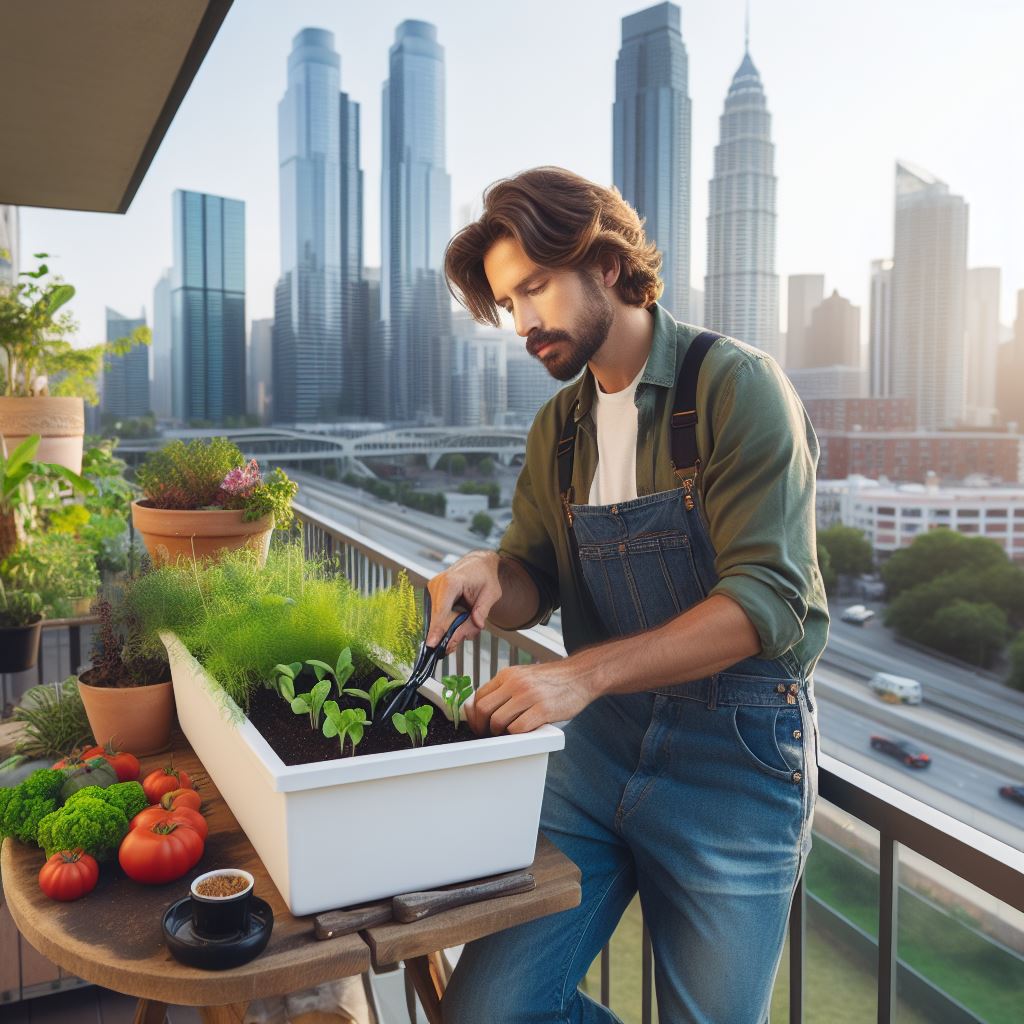Introduction
Overview of the growing interest in urban green spaces
Balcony Farms Urban Green Spaces, encompassing areas like parks and gardens, have garnered substantial attention in recent years.
People are recognizing the importance of these areas for both environmental and social benefits.
As urbanization increases, the need for such spaces becomes even more crucial.
Definition and significance of balcony farms
Balcony farms are a type of urban green space where individuals grow plants and crops on their balconies.
These small-scale farms allow people to connect with nature and engage in sustainable practices within the limited space of their apartments or homes.
Balcony farms offer numerous benefits
They improve air quality, provide fresh produce, and create a sense of well-being among city dwellers.
Additionally, balcony farms promote self-sufficiency, as individuals can grow their own food and reduce their reliance on commercial agriculture.
The significance of balcony farms extends beyond personal benefits.
These green spaces contribute to the overall greening of urban areas, enhancing biodiversity and mitigating the heat island effect.
They also foster a sense of community as neighbors can exchange gardening tips and share their harvests.
Basically, balcony farms represent an innovative approach to urban gardening, allowing individuals to create their own green oasis in the midst of concrete jungles.
As the interest in urban green spaces continues to grow, the importance of balcony farms cannot be overstated in providing sustainable and livable cities for current and future generations.
Benefits of Balcony Farms
A balcony farm is not just a trendy addition to urban living, it also offers numerous benefits that contribute to a healthier and more sustainable lifestyle.
Let’s explore some of these advantages:
Improved air quality
One of the most significant benefits of balcony farms is the improved air quality they provide.
Transform Your Agribusiness
Unlock your farm's potential with expert advice tailored to your needs. Get actionable steps that drive real results.
Get StartedPlants are natural air purifiers as they absorb carbon dioxide and release oxygen through photosynthesis.
Having a mini farm on your balcony can help reduce air pollution in urban environments.
Reduction of urban heat island effect
Urban areas tend to have higher temperatures compared to rural regions due to the heat-absorbing properties of concrete and asphalt.
Balcony farms can act as green spaces that help reduce the urban heat island effect by absorbing and dissipating heat, creating a more pleasant microclimate.
Access to fresh produce
With balcony farms, urban dwellers can enjoy access to fresh and organic produce right at their doorstep.
Growing vegetables, fruits, and herbs on your balcony not only ensures quality but also saves you money while promoting a healthier diet.
Enhancing mental well-being
Being surrounded by greenery and interacting with plants have proven psychological benefits.
Balcony farms can serve as soothing spaces where you can relax, engage in gardening, and reduce stress levels.
They provide a sense of connection with nature, even in the heart of the city.
Promoting biodiversity
By creating balcony farms, we contribute to the promotion of biodiversity in urban areas.
These green spaces attract birds, bees, butterflies, and other beneficial insects, creating a more balanced ecosystem.
The presence of diverse plant species encourages pollination and helps maintain a healthy and sustainable environment.
In general, balcony farms offer numerous benefits that go beyond simply growing plants in an urban setting.
They improve air quality, reduce the urban heat island effect, provide access to fresh produce, enhance mental well-being, and promote biodiversity. Incorporating a mini farm on your balcony not only adds beauty but also contributes to a more sustainable and healthier future.
Transform Your Agribusiness Online Presence
Stand out with compelling content tailored to engage your audience and drive results. From blog posts to social media, we’ll create what your business needs to grow.
Get StartedRead: Window Farms: A Small-Scale Revolution
Getting Started with Balcony Farms
Evaluating balcony size and orientation
- Measure the size of your balcony to determine how many plants it can accommodate.
- Consider the orientation of your balcony to understand how much sunlight it receives throughout the day.
- Take into account any obstructions that may block sunlight or create shade.
Choosing suitable containers
- Select containers that are appropriate for the size and weight of your plants.
- Ensure that the containers have drainage holes to prevent waterlogging.
- Consider using self-watering containers or drip irrigation systems for convenience.
Selecting appropriate plants
- Choose plants that are suitable for the amount of sunlight your balcony receives.
- Consider the size of the plants and their growth patterns to ensure they fit in your available space.
- Research the water and soil requirements of each plant to ensure they can thrive on a balcony.
Understanding sunlight and watering requirements
- Monitor the amount of sunlight your balcony receives to determine the best positioning for your plants.
- Water your plants regularly, taking into account their specific watering needs.
- Adjust your watering schedule based on the season and weather conditions.
Introducing beneficial insects
- Insects such as ladybugs and bees can help with pollination and pest control in your balcony farm.
- Research which beneficial insects are suitable for your plants and how to attract them.
- Avoid using harmful pesticides that can harm these beneficial insects and the environment.
By following these steps, you can create a thriving urban green space right on your balcony.
Evaluating your balcony size and orientation, choosing suitable containers, selecting appropriate plants, understanding sunlight and watering requirements, and introducing beneficial insects are all vital aspects of getting started with balcony farms.
Read: The Urban Farmer’s Guide to Success
Essential Techniques for Balcony Farming
Container Gardening
Container gardening is a popular technique for balcony farming as it allows plants to be grown in limited spaces.
The first step in container gardening is selecting the right containers that are deep and spacious enough for plant growth.
Choose containers made of materials such as plastic, ceramic, or wood that provide proper drainage for the plants.
Ensure the containers have drainage holes at the bottom to prevent waterlogging and root rot.
Fill the containers with high-quality potting mix that is lightweight, well-draining, and rich in organic matter.
Select suitable plants for container gardening, considering their size, sunlight requirements, and compatibility.
Regularly water the plants as containers tend to dry out faster than traditional garden beds.
Monitor the moisture levels by sticking your finger into the soil and water when needed to keep the plants hydrated.
Fertilize the container plants with a balanced organic fertilizer to provide essential nutrients for healthy growth.
Prune and trim the plants regularly to maintain their shape and prevent overgrowth on the balcony.
Unlock Farming Insights for Growth
Make smarter farming decisions with detailed reports on market trends, weather patterns, and soil health tailored to your farm's success. Boost productivity with actionable data.
Get ReportImplement proper pest control methods to protect the container plants from insects and diseases.
Vertical Gardening
Vertical gardening is an excellent technique to maximize space utilization on balconies, especially in high-rise buildings.
Install vertical gardening structures such as trellises, hanging pots, or wall-mounted planters to grow plants vertically.
Choose vining or trailing plants that can climb or trail down the vertical structures for an aesthetically pleasing display.
Ensure the vertical structure is sturdy and can support the weight of the plants and containers.
Regularly train and guide the plants to climb or trail along the vertical structures using garden twine or plant ties.
Water the vertical garden thoroughly, considering the water drainage and the vertical distance between plants and containers.
Monitor the plants closely for any signs of overcrowding, as they may compete for sunlight, water, and nutrients.
Regularly check the vertical structure for stability and make adjustments if necessary to prevent accidents.
Companion Planting
Companion planting is a technique where certain plants are grown together to mutually benefit each other.
Select companion plants that have compatible growth habits, nutrient requirements, and pest repelling properties.
For example, planting marigolds alongside tomatoes can help repel pests such as nematodes and aphids.
Onions and garlic are excellent companions for many plants as they repel pests and provide natural fungicidal properties.
Avoid planting incompatible plants together, as they may compete for resources or release chemicals that inhibit growth.
Rotate companion plants each growing season to prevent the buildup of pests and diseases in the soil.
Soil Composition and Fertilization
Creating the right soil composition is crucial for successful balcony farming.
Use a combination of quality potting mix, compost, and organic matter to enrich the soil with nutrients.
Ensure the soil mixture is well-draining, aerated, and has good water retention capabilities.
Regularly amend the soil with compost or organic fertilizers to replenish nutrients for plant growth.
Avoid over-fertilization, as it can result in nutrient imbalances and damage to the plants.
Test the soil periodically to monitor its pH level and adjust if necessary to promote optimal plant growth.
Pest and Disease Management
Effective pest and disease management is essential for maintaining healthy balcony farm plants.
Regularly inspect the plants for signs of pests such as aphids, spider mites, or snails, and remove them manually.
Introduce beneficial insects like ladybugs or lacewings to control aphid populations naturally.
Use organic pest control methods such as neem oil, insecticidal soaps, or homemade remedies to treat pest infestations.
Prevent diseases by practicing good hygiene, avoiding overcrowding, and providing proper air circulation for the plants.
Remove infected plants or parts immediately to prevent the spread of diseases to healthy plants.
Avoid using chemical pesticides unless absolutely necessary, as they can harm beneficial insects and the environment.
By mastering these essential techniques, balcony farmers can create thriving urban green spaces that bring nature closer to home.
Read: Mobile Markets: Bringing Farms to Cities
Successful Examples of Balcony Farms
Case studies of thriving balcony farms in urban areas
- In the heart of New York City, a small apartment balcony has been transformed into a flourishing farm. The owners successfully grow a variety of vegetables, herbs, and even fruit trees in their limited space.
- London’s urban sprawl hasn’t stopped residents from embracing balcony farming. One particular case study showcases a balcony farm on the 30th floor, where the owners successfully grow lettuce, tomatoes, and peppers.
- Barcelona, Spain has been a pioneer in urban farming. Through innovative balcony farming techniques, residents have cultivated a wide range of vegetables, creating a sustainable urban food system.
- Tokyo, Japan, known for its sky-high real estate prices, has seen a rise in balcony farming. Many residents have turned their balconies into miniature rice fields and vegetable gardens, providing fresh produce for themselves and their communities.
Inspiring stories of individuals and communities adopting balcony farming
- Sarah, a young professional living in a high-rise building, started a balcony farm as a way to reconnect with nature. Her story inspired other residents to follow suit, resulting in a community of urban balcony farmers.
- In a low-income neighborhood, a group of residents came together to convert their balconies into productive green spaces. Through shared knowledge and resources, they created a sustainable food source, improving their community’s access to fresh produce.
- John, a retired individual, found solace and purpose in balcony farming. By tending to his plants, he rediscovered his passion for gardening and became an active participant in his local farmers market.
Innovative methods and practices
- Vertical gardening is a popular technique used in balcony farms. By utilizing wall-mounted planters and trellises, urban gardeners maximize their space and grow crops vertically, increasing yield.
- Hydroponics, a soil-less cultivation method, has revolutionized urban farming. By using nutrient-rich water solutions, balcony farmers can produce higher quality crops in a controlled environment.
- The use of urban composting systems has allowed balcony farmers to minimize waste and enrich their soil naturally. By recycling kitchen scraps and organic materials, they create nutrient-rich compost for their plants.
- Community-supported agriculture (CSA) programs have been successfully implemented in balcony farms. Neighbors come together to purchase shares in a balcony farm, receiving fresh produce regularly and building a sense of community.
- Green roofs, another innovative method, have been utilized by some urban dwellers to expand their farming space. By transforming rooftops into flourishing gardens, balcony farmers can grow a wider variety of crops, contributing to urban biodiversity.
In essence, the success of balcony farms can be seen through various case studies, inspiring stories, and innovative methods.
These examples prove that even in dense urban areas, individuals and communities can create thriving green spaces and contribute to sustainable food production.
Read: Urban Farming: Boosting Food Security

Find Out More: Water Conservation in Farms
Overcoming Challenges in Balcony Farming
Limited space and resources
- Balcony farming requires strategic planning to make the most of limited space.
- Vertical gardening techniques like trellises or hanging baskets can maximize space utilization.
- Utilize small containers and modular systems to grow a variety of plants in a compact area.
- Utilize innovative techniques like hydroponics or aeroponics, which require minimal soil and water.
Noise and pollution considerations
- Choose plants that have the ability to tolerate urban conditions and air pollution.
- Install green walls or screens to buffer noise and filter pollutants from the surroundings.
- Regularly dust off plants to ensure they are not accumulating pollutants on their leaves.
- Use organic, non-toxic fertilizers and pesticides to minimize pollution and protect the environment.
Dealing with outdoor climate changes
- Research and select plants that are well-suited to the local climate and can withstand temperature changes.
- Install shade structures or use umbrellas to protect plants from excessive heat or direct sunlight.
- During extreme weather conditions, move potted plants indoors or to a sheltered area to prevent damage.
- Implement proper irrigation and watering practices to avoid water stress during hot or dry periods.
Ensuring proper drainage and preventing water damage
- Use containers with adequate drainage holes to prevent water logging and root rot.
- Place saucers or trays underneath containers to catch excess water and prevent damage to the balcony.
- Regularly check for clogged drainage holes and clear them to maintain proper water flow.
- Avoid overwatering by ensuring that the soil is slightly moist but not waterlogged.
Balancing aesthetics and functionality
- Incorporate aesthetic elements like colorful planters, decorative accents, or vertical garden structures.
- Choose plants with different textures, heights, and colors to create visually appealing arrangements.
- Consider the functionality of the balcony space by leaving room for seating, relaxing, or entertaining.
- Regularly maintain and groom plants to ensure they remain vibrant and visually pleasing.
In a nutshell, while balcony farming may present certain challenges, they can be overcome with careful planning and implementation.
By making the most of limited space and resources, considering noise and pollution factors, adapting to climate changes, ensuring proper drainage, and balancing aesthetics and functionality, balcony farming can successfully bring urban green spaces into our lives.
Uncover the Details: Fall’s Finest: Seasonal and Local Eating
Uncover the Details: Fresh & Local: Amy’s Farming Journey
Gain More Insights: How Organic Farming Fights Climate Change
Tips to Maximize Balcony Farming Experience
Regular maintenance and monitoring
- Set a schedule for watering, weeding, and checking the health of your plants.
- Remove any dead or diseased plants as soon as you notice them.
- Regularly inspect for pests and take appropriate actions to prevent an infestation.
Experimenting with different plant varieties
- Try growing a mix of vegetables, herbs, flowers, and fruits to diversify your balcony farm.
- Research which plants are suitable for your climate and balcony conditions.
- Keep track of the results and adjust your selection based on what thrives best.
Networking with local gardening communities
- Join local gardening clubs or online communities to connect with fellow balcony farmers.
- Exchange tips, advice, and experiences with other like-minded individuals.
- Attend workshops or gardening events to expand your knowledge and learn new techniques.
Incorporating sustainable practices
- Use organic fertilizers and natural pest control methods to promote a healthy balcony ecosystem.
- Practice composting to reduce waste and create nutrient-rich soil for your plants.
- Consider rainwater harvesting to minimize water consumption.
Celebrating and sharing successes
- Take pride in your balcony farm’s achievements, no matter how small.
- Share your experiences and knowledge with friends, family, and social media followers.
- Inspire others to start their own balcony farms and create a greener urban environment.
By following these tips, you can maximize your balcony farming experience and create a thriving green space in the heart of the city.
Conclusion
Balcony farms offer numerous benefits and have great potential for urban areas.
With limited space in cities, balcony farming provides an opportunity to grow fresh produce and plants.
Not only does it contribute to sustainable living, but it also improves air quality and reduces waste.
Moreover, balcony farms can enhance mental and physical well-being, creating a sense of tranquility in busy urban environments.
We encourage readers to explore balcony farming opportunities and experience the joy of growing their own food.
By taking advantage of vertical space, anyone can become a part of the urban farming movement.
Imagine the satisfaction of harvesting your own herbs and vegetables right outside your doorstep.
In the future, urban green spaces like balcony farms will play a crucial role in building healthier and more sustainable communities.
They can bring people together, foster community engagement, and promote environmental consciousness.
With the increasing focus on sustainability and the need for green spaces in cities, balcony farms are poised to become an integral part of urban living.
So, let us embrace this concept, transform our balconies, and create a greener, healthier future for ourselves and our communities.




